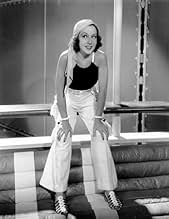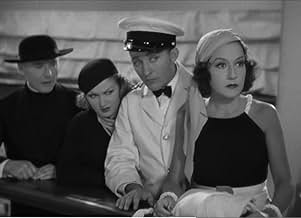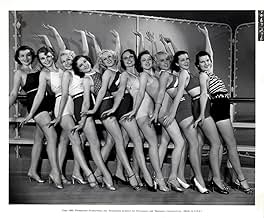अपनी भाषा में प्लॉट जोड़ेंYoung man falls for blonde heiress forced onto ship. Follows to rescue her, disguising as mobster's aide when realizing she's returning home and his boss is aboard.Young man falls for blonde heiress forced onto ship. Follows to rescue her, disguising as mobster's aide when realizing she's returning home and his boss is aboard.Young man falls for blonde heiress forced onto ship. Follows to rescue her, disguising as mobster's aide when realizing she's returning home and his boss is aboard.
Jack Adair
- Federal Man
- (बिना क्रेडिट के)
Philip Ahn
- Ling
- (बिना क्रेडिट के)
कहानी
क्या आपको पता है
- ट्रिवियाW.C. Fields was replaced before filming began with Charles Ruggles.
- गूफ़During "Sailor Beware," there is a shot of deckhands strumming guitars at a much faster tempo than the song itself, suggesting that it's stock footage from another film.
- भाव
[first lines]
Reno Sweeney: [singing] In olden days a glimpse of stocking / Was looked on as something shocking, / Now, Heaven knows, / Anything goes!
[as she sings the words "anything goes", the title of the film appears onscreen]
- कनेक्शनFeatured in Paramount Presents (1974)
फीचर्ड रिव्यू
The closest you'll ever come to hearing a faithful recording of Cole Porter's original score is by listening to the faithful 1988 studio cast recording directed by John McGlinn, which uses (as much as possible) the original orchestrations of Robert Russell Bennett and Hans Spialak.
However, that doesn't mean you should ignore this revamped film version, which has historical interest because it preserves one of the few film performances of Ethel Merman. The Broadway show, which opened in 1934 and ran for 420 performances (quite a long run in those days), actually gets better treatment than other Porter musicals adapted for film. I have in mind "DuBarry was a Lady," the 1943 vehicle that stars Lucille Ball, Gene Kelly and Red Skelton, and "Something for the Boys" (1944).
"Anthing Goes," which was renamed "Tops Is the Limit" to prevent confusion with the 1956 remake, again starring Bing Crosby, is more of a vehicle for Crosby than anyone else, which is why outside songwriters were brought in to provide him with material more suited to his vocal skills.
Only three of Porter's songs are given anything resembling a full treatment (albeit with laundered lyrics): "You're the Top," "I Get a Kick Out of You" and "There'll Alway Be a Lady Fair." Other songs are used as background or underscoring (e.g., "All Through the Night," "Blow, Gabriel, Blow.").
In the original cast, Merman was joined by two big Broadway stars -- William Gaxton and Victor Moore -- as well as a lady named Vivian Vance, while the film gives us, besides Crosby and Merman, Charles Ruggles, Ida Lupino and the veddy, veddy English Arthur Treacher.
The plot, such as it is, hardly matters. In her autobiography "Who Could Ask for Anything More," Ethel Merman tells why:
" ...the writers who used to think up the books that were wrapped around Gershwin or Cole Porter scores, started from scratch, which only their bare cupboards and an unmanageable sense of humor to guide them. First a producer signed a cast; then he hired writers to rustle up some material for that cast to use. 'I've got Bert Lahr,' he'd say. Or 'I've got Victor Moore. Get going' buddy. Make with the Moore-type yoks.' " In the mid-1950s, Merman and Frank Sinatra performed in "Anything Goes" on television. The program was later released on a bootleg album. If enjoy the film, with a little research you'll even find it on DVD.
Enjoy the hijinks, singing and production numbers.
However, that doesn't mean you should ignore this revamped film version, which has historical interest because it preserves one of the few film performances of Ethel Merman. The Broadway show, which opened in 1934 and ran for 420 performances (quite a long run in those days), actually gets better treatment than other Porter musicals adapted for film. I have in mind "DuBarry was a Lady," the 1943 vehicle that stars Lucille Ball, Gene Kelly and Red Skelton, and "Something for the Boys" (1944).
"Anthing Goes," which was renamed "Tops Is the Limit" to prevent confusion with the 1956 remake, again starring Bing Crosby, is more of a vehicle for Crosby than anyone else, which is why outside songwriters were brought in to provide him with material more suited to his vocal skills.
Only three of Porter's songs are given anything resembling a full treatment (albeit with laundered lyrics): "You're the Top," "I Get a Kick Out of You" and "There'll Alway Be a Lady Fair." Other songs are used as background or underscoring (e.g., "All Through the Night," "Blow, Gabriel, Blow.").
In the original cast, Merman was joined by two big Broadway stars -- William Gaxton and Victor Moore -- as well as a lady named Vivian Vance, while the film gives us, besides Crosby and Merman, Charles Ruggles, Ida Lupino and the veddy, veddy English Arthur Treacher.
The plot, such as it is, hardly matters. In her autobiography "Who Could Ask for Anything More," Ethel Merman tells why:
" ...the writers who used to think up the books that were wrapped around Gershwin or Cole Porter scores, started from scratch, which only their bare cupboards and an unmanageable sense of humor to guide them. First a producer signed a cast; then he hired writers to rustle up some material for that cast to use. 'I've got Bert Lahr,' he'd say. Or 'I've got Victor Moore. Get going' buddy. Make with the Moore-type yoks.' " In the mid-1950s, Merman and Frank Sinatra performed in "Anything Goes" on television. The program was later released on a bootleg album. If enjoy the film, with a little research you'll even find it on DVD.
Enjoy the hijinks, singing and production numbers.
टॉप पसंद
रेटिंग देने के लिए साइन-इन करें और वैयक्तिकृत सुझावों के लिए वॉचलिस्ट करें
- How long is Anything Goes?Alexa द्वारा संचालित
विवरण
बॉक्स ऑफ़िस
- बजट
- $11,00,000(अनुमानित)
- चलने की अवधि1 घंटा 32 मिनट
- रंग
- पक्ष अनुपात
- 1.37 : 1
इस पेज में योगदान दें
किसी बदलाव का सुझाव दें या अनुपलब्ध कॉन्टेंट जोड़ें



































